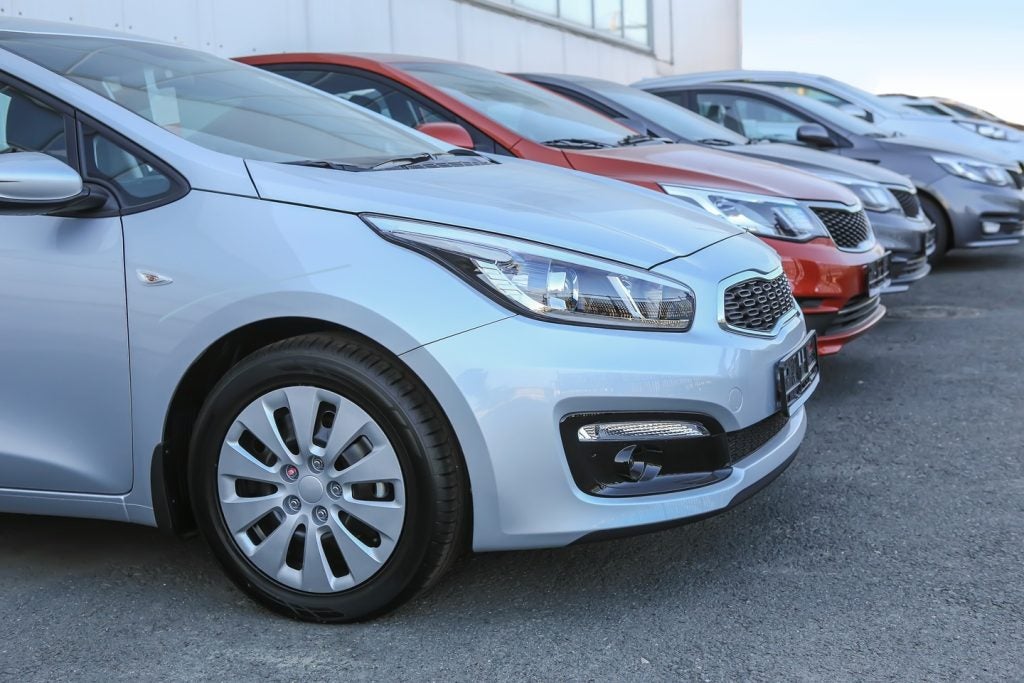Jo Tacon reports from the Motor Finance Europe conference in
London
How times change. When the theme of the 2008 Motor Finance
Europe conference was decided upon, the landscape within the
industry looked decidedly different to how it appears now. A year
ago, motor financiers and lessors were concerned about
differentiating themselves from the competition, and turning a
profit in sophisticated markets where new channels – primarily
internet-based – were causing upset to the established players. We
hit upon the tagline “Making money in mature markets” to sum up
these concerns, and to give shape to what we wanted to discuss on
the day.
Now, twelve months later, all of these concerns are still of
vital importance to the industry, but they have been superseded in
large part by the credit crisis, and its still-unfolding
consequences for lenders and lessors. The conference, therefore,
provided a useful space both to discuss the impact of the credit
crunch, and to examine the importance of innovation and
differentiation in a demanding and changeable marketplace.
Happily for delegates, the one message which came through in
almost every presentation was that the credit crunch does not
necessarily mean the end for motor financiers and lessors, and that
it may in fact lead to greater business volumes, as individuals and
companies that find themselves short of cash or unable to borrow as
much as previously turn to finance and leasing as a way of
spreading the cost of a new vehicle.
Sobering message for dealers
Peter Cottle, senior director at Bank of Scotland Dealer
Finance, started the ball rolling, with his presentation on the
challenges and opportunities facing point-of-sale finance. Any
early morning cobwebs which had not already been dispelled by a cup
of coffee or two were summarily dismissed by the beginning of
Cottle’s presentation, which he kick-started with a video of a
recent US ad for the Jeep Liberty, featuring singing animals and a
bemused driver.
How well do you really know your competitors?
Access the most comprehensive Company Profiles on the market, powered by GlobalData. Save hours of research. Gain competitive edge.

Thank you!
Your download email will arrive shortly
Not ready to buy yet? Download a free sample
We are confident about the unique quality of our Company Profiles. However, we want you to make the most beneficial decision for your business, so we offer a free sample that you can download by submitting the below form
By GlobalData
 Picking up the theme that dealers have all the tools they
Picking up the theme that dealers have all the tools they
need to succeed at selling finance and insurance (F&I) products
at the point of sale (PoS) if they take the right approach, Cottle
highlighted the recent progress of the Finance & Leasing
Association’s Specialist Automotive Finance (SAF) campaign since
October 2007.
3,200 dealer staff have taken the SAF test so far, with 12 out
of the top 20 dealer groups signed up to the programme; however,
Cottle believes more buy-in from the motor industry is needed
before SAF can reach its full potential. The next steps, Cottle
revealed, are to introduce dealer accreditation showing all of a
dealer’s staff are SAF-accredited, and to improve showroom
branding.
“It would be wrong to say that everything is rosy, but overall
we seem to have stemmed the steady decline in point-of-sale,”
Cottle said (see box 1). He warned funders to beware
volatile used car prices, a growing tide of voluntary terminations,
and declining dealer profitability margins – down to 0.75 on
average, down from the “dizzy heights of 3 per cent” a few years
ago. To combat these threats, Cottle noted that professionally-sold
secured finance could be more attractive to consumers, even to
cash-rich carbuyers who, in these turbulent times, may prefer to
keep their cash in the bank. As unemployment levels rise, too,
credit protection insurance may come back into fashion following
the recent battering it has taken to its reputation, he suggested.
Thinning dealer margins will also persuade retailers back into
sales of this kind of insurance, he noted.
The cross-sales challenge
Joe McCormack, head of affinity sales at Cardif Pinnacle pointed
out that research his company has commissioned found that 65 per
cent of dealer customers had established finance before setting
foot in the showroom – and that retailers’ websites are not geared
up to push the F&I message to curious browsers, with not one
out of seven representative retailers’ websites surveyed displaying
information about finance offers. Moreover, 40 per cent of used car
customers are not even offered finance, Cardif’s research found.
“If you’re not even talking to customers about your products,
you’re not going to cross-sell them anything,” McCormack
said.
McCormack did not shy away from describing the recent travails
of the payment protection insurance (PPI) sector: “It is fair to
say that core PPI has taken a battering.” He took heart, however,
from a recent headline in the Mirror exhorting readers to
“take [PPI] cover” in order to survive the credit crunch – “this is
manna from heaven for our industry,” he said. Sales of GAP and RTI
have risen over the past two years from £187m to £208m, while sales
of PPI have fallen over the same period from £137m to £89m, Cardif
found. Does this mean that growth in sales of GAP and RTI
necessarily leads to a fall in PPI volumes? No, he claimed – the
products are complementary, not competing, and there is room for
them all in the marketplace.
McCormack urged delegates to “make the most of the opportunity”
provided by the credit crunch to increase F&I sales, as high
street lenders make loans harder to come by. He also warned that
companies which did not learn to make full use of the possibilities
of the internet were doomed to fail, as the “web generation” came
of age, and as aggregator sites exert downward pressure on pricing.
Every “contact point” with the consumer – from first website visit
to servicing – should be seen as a potential cross-selling opening,
he emphasised.
Going for brokers
Robert Kingdom, head of marketing and business development (UK)
at Masterlease talked about the problems facing fleets that want to
crack the SME market – and the “huge amount of profit opportunity”
within the market. The very composition of the SME market presents
difficulties – from single operators needing one company car where
choice is lifestyle-driven, to fleets of up to a few dozen vehicles
with different models for different job roles. “It is simply a
numbers game,” Kingdom said, emphasising the need to make contacts
within the SME community, whether on the internet, through
telemarketing, or direct mail.
With the UK’s 6,000 or so vehicle finance brokers earning around
£800 per unit – which Kingdom pointed out is “two to three times”
what a volume franchised retailer could expect to make on the same
deal – the broker channel is clearly a model which works. “Brokers
are very good at selling what they want to sell – at
switch-selling,” Kingdom noted. If a broker has a special offer on
one model, “nine times out of ten” they will manage to persuade
customers specifically enquiring about a different model into the
special offer vehicle instead. “And after three years, they will
put them into whatever marque they want – they have no brand
loyalty,” he added.
Brokers are an important channel for fleets that want to reach
SMEs, Kingdom said, as they talk the same language as their
customers – their websites shout about “deals” and “offers”. He
also pointed out that the “small business” market segment was in
all probability far larger than the official SMMT estimate, which
put its overall share at 8 per cent; an ICDP estimate of 23 per
cent of the market seemed more credible, he opined.
Green update
Mike Waters pointed out the “popularity of the number 20” among
European regulators – CO2 emissions to be reduced by 20 per cent by
2020, transport fuel to be composed of 20 per cent biofuel by 2020,
and 20 per cent of energy to come from renewable sources by 2020.
“These present significant challenges to fleets and manufacturers,”
he said. Fuel mix is particularly controversial – Germany shelved
plans to introduce 10 per cent biofuel into petrol when it was
found that 3.7m German vehicles could not run on the mix, while
concerns surrounding the production of biofuel at the expense of
food for human consumption have been much in the news of
late.
Greening a fleet need not necessarily involve taking on more
risk. “The real risk is not doing anything,” Waters noted.
“Environmental performance in many sectors is a prerequisite.”
Waters called on fleets to think critically about green
initiatives: “18 months ago biofuels were the answer – now that has
changed. There are also dangers in being first, as anyone who
bought heavily into LPG vehicles can attest.” At the moment, the
future fuel choice for fleets remains unclear, as chart 1
shows.
Waters asked, provocatively, whether fleets would be prepared to
deliver fewer vehicles to customers in future, based on declining
need for cars as other methods of mobility take over – and what
avenues for profit fleets could envisage to replace that lost
revenue. “Are you prepared to step outside the pure provision of
motor finance?” he asked.

Measuring performance?
Guy Doole, managing director at BenchMark Consulting
International UK, presented research carried out by BenchMark among
top senior motor finance executives, specifically for the Motor
Finance Europe conference. Among other findings, Doole highlighted
the perceived importance of both efficiency and customer
orientation to motor finance executives (see chart 2). The
importance of collecting and measuring data pertaining to an
organisation’s efficiency also came out loud and clear from the
respondents, with “knowledge the key to organisational efficiency,”
Doole reported.
Looking to the future, none the respondents anticipated a
fall in demand for leasing and finance products (see chart
3). 83 per cent expect an increase in cost of funds due to the
credit crunch, with 64 per cent predicting a rise in funding costs
of up to 0.5 per cent (see chart 4).



Rating for risk
The credit crunch was at the heart of the presentation by Nigel
Williams, senior planning manager at Black Horse Motor Finance,
who, like other speakers, was of the opinion that a narrowing in
the availability of credit elsewhere, and greater pressures on
consumers’ budgets due to higher mortgage costs, will open up
greater opportunities for motor financiers, as people increasingly
look to spread the cost of a car purchase – but are unable to get
the super-cheap credit rates of the recent past.
Thirty years ago, Williams pointed out, when motor finance was
first developed, it was a peripheral, and a sales aid for the
dealer that was not seen as core to operations; today, income from
F&I sales can mean the difference between profit and loss, and
it is offered to a far wider range of customers than in the
past.
But are rates customers are offered in the showroom suited to
their risk profiles? Williams said that in many cases, the answer
is no; having flat rates means losing income from higher-risk
customers who might have accepted a higher rate, and losing
business from low-risk customers who find more attractive credit
sources elsewhere (see figure 2). Last year, Williams
talked about the possibility of pricing loans according to risk;
this year, having run pilot schemes, he was able to report on the
results Black Horse had achieved through this approach.
The new pricing model can benefit both parties. “If we are
providing pricing solutions that are specific to customers, we are
going to have much happier customers,” Williams said, adding that
having “more appropriate” rates helped with the problem of early
settlements by cutting attrition levels, and increasing customer
satisfaction rates.
However, the new model requires a “new sales track”, according
to Williams, requiring flexibility. Early trials with selected
dealers have been encouraging, he reported, with good levels of
take-up and high customer and dealer satisfaction. Any concerns
surrounding risk-based pricing and the ‘treating customers fairly’
guidelines from the FSA can be addressed by making the process
“transparent”, Williams stressed, pointing out that at present,
many customers are not eligible for the headline rates advertised
in dealerships. “We are offering different people different rates
with a strong rationale behind it,” Williams concluded.


Captive benefits
Dr Frank Stenner, former CEO of BMW Bank talked about the
opportunities open to captive finance houses, which he called “the
profit centre of the 21st century market.” Premium manufacturers
make under 25 per cent of their profits from F&I activity, as
they are able to make money selling cars, whereas for volume
manufacturers the profit contribution from F&I is “often above
the 40 per cent level,” Stenner said, highlighting its
importance.
“Now the emphasis of captive finance is shifting to customer
relationship management,” he claimed, with tailor-made packages
designed to enhance loyalty rates. “Finance and lease customers’
brand loyalty rates are much higher than for those customers who
choose to pay by cash,” Stenner pointed out. “Thus captive finance
houses play a key role in strengthening and protecting the
manufacturers’ automotive brands.” However, this means that service
levels from captives must live up to customer expectations, or they
risk damaging the brand.
Captives are uniquely poised to take advantage of synergies with
dealers and manufacturers in back-office systems and promotional
opportunities, Stenner noted, while their add-on products – such as
branded credit cards or online deposits – create loyalty and drive
customers back to dealers and manufacturers. “30 per cent of
deposit customers drive competitors’ brands. They are hot targets
for the marketing department,” he said. As a bonus, customer
deposits help shield captives from the effects of an upturn in the
cost of funds, Stenner observed.
A view from the showroom
How to maximise the opportunity of financial services was the
essence of the presentation by Steve Archer, director of strategy
and innovation at retailer Inchcape. Archer harked back to the
“good old days” of PoS finance, where the arrival of the first fax
machine was treated with wonder and puzzlement, underwriting took
two to three days, documents were delivered by hand and the pub
lunch was still an integral part of the working week. “This is the
situation we face in our emerging markets,” Archer said, pointing
to the potential he believes exist for financiers and retailers in
less sophisticated regions.
“If ‘F’ gets a little bit harder, then there’s plenty of room to
make up the difference in ‘I’ products of one form or another – for
me, the important thing is to do the deal at any cost,” he said,
stating that he would rather do a finance deal at a small loss
because of the opportunity to sell add-on products. “We will make
more profit selling a finance customer more products, and I’ve seen
this in our own books,” Archer observed.
He pointed out that retailers and financiers have a potential
difference of interest regarding loan terms and vehicle turnover,
with financiers having a vested interest in keeping customers on
their books for as long as possible, while retailers look to work
with their partners to encourage customers back into the showroom
to get them to buy more cars. “I’m not sure where the solution is,”
he added.
“PCP is the product for the showroom – I am a big fan,” Archer
said. “We are working with partners to drive the PCP product as it
is unique to showrooms and a real selling point.”
The strategy of Inchcape has been to “leverage its scale” and to
partner finance institutions, acting as a broker by “introducing
F&I customers to the experts”. Inchcape has just signed a deal
with software house SAP to roll out a global dealer management
system across all its 26 country operations – “which is a huge,
huge deal for us and a multi-million pound investment, but has to
be the way to go in future,” Archer said. Lenders must work with
dealers to think outside the box and come up with innovative
products, he added.
Looking East
 Picking up on Archer’s view that emerging markets hold huge
Picking up on Archer’s view that emerging markets hold huge
potential for growth, Pierantonio Rumignani, head of business
development at UniCredit Consumer Financing Bank, spoke of the low
levels of vehicle ownership in countries such as Turkey and Russia,
the expected growth of sales in developing markets (see figure
4), which far outstrips the sluggish growth predicted for
Western Europe, and the relative age profile of the car parcs in
Eastern and Western Europe (see chart 5), where a far
greater need for renovation exists.
With these prevailing trends, Rumignani argued, motor
financiers should look to new markets for new profit openings.
“It’s a completely different world from what you know in the UK and
other European countries,” he said, observing that growth rates in
Central and Eastern Europe are predicted to be “two to three times”
higher than in Western Europe (see table 1). Motor finance
is an excellent vehicle to entrance into new markets, due to its
inbuilt risk mitigation (with capital recoverable in the form of
the financed vehicle), above-average ticket values, and longer
duration of loans.


The sub-prime opportunity
The credit crunch, which had been remarked upon in many of the
day’s presentations, was the centrepiece of Dr Roger Gewolb’s talk
on sub-prime finance. “Today you’re sub-prime,” he told the
audience. “We need to regard our customers as somewhat less prime
than we used to. Everything is worth way, way less than it was.
This means different risk management, different collections
procedures, different evaluation.” The UK is “super-prime” compared
to the US, Gewolb noted, but the lessons still compare, although
“even if something goes wrong with our mortgages it won’t be as bad
as in the States,” which was a reassuring message for
delegates.
Gewolb, the CEO of Park Motor Finance, told delegates how he has
been receiving thank-you letters from borrowers he lent to at 40
per cent APR for 12 years, because his competitors’ “good book”
started at 80 per cent, and was “around 300 per cent” on average.
“The risk-to-reward ratio is fantastic, because if you manage the
business right, incrementally you will have not that much more in
arrears and bad debts.”
Gewolb warned of overlending in the non-prime car finance
market, which had caused many of his competitors to come to grief
in recent months. “They [the other sub-prime lenders] were lending
more than they should in order to entice dealers into giving them
the lion’s share of their business,” he said, “and they
over-automated their credit decision process.” While prime
financiers deliver a verdict in six seconds, a typical “prop” to
Park will have a turnaround time of 45 minutes – “you cannot do
these things by an auto score.”
Treating customers fairly was another key plank to his
presentation. “Did you know that the OFT has already identified
£6.6bn-worth of what it calls ‘customer detriment’ in our industry
in the last twelve months?” he asked attendees. “This is going to
be very big.” He warned that companies which are not diligent in
their TCF compliance will be punished. He also warned, in a TCF
context, about “over-burdening customers with debt”, decrying a
fairly recent phenomenon whereby certain sub-prime players had lent
£13,000 on cars with a book value of £10,000.
His formula for successful arrears management is “manual
intervention, and experienced collectors.” Raw credit scores
are not enough by themselves to make a credit decision, he
emphasised, as relying on numbers alone leads to “throwing out the
baby with the bathwater”, and rejecting far too many viable
propositions.
In an environment where the cost of funds has skyrocketed,
Gewolb encouraged more companies to dip a toe into the non-prime
arena where “great rewards are available for little incremental
risk” – although “careless practices will hurt the whole
industry.”
Reaching the internet generation
The final speech of the day was given by Graham Wheeler, CEO of
Volkswagen Financial Services (VWFS) UK, who chose to look at
e-commerce and the rise in importance of the internet.
With 98 per cent of internet users unhappy about spending more
than £1,000 online at any time, Wheeler said dealers could relax –
for the moment. 6 per cent of cars in the UK were sold online in
2007, he pointed out, meaning 94 per cent were sold by more
traditional means; however, the number of vehicles retailed online
“is only going to grow”. At the moment, carbuyers primarily use the
internet as a source of information, which should be “reassuring”
for motor financiers. But some manufacturers and motor financiers
are grasping the nettle and creating a significant and
user-friendly online presence in order to establish stronger links
with customers; Toyota’s US operations were picked out as a
particularly good example of this.
A study by McKinsey has found that by 2010, normal TV
advertising will only be one-third as effective as in 1990, due to
falling audiences; marketing budgets are increasingly geared
towards the web. “With hundreds of channels these days, when an ad
comes on people simply switch over – but the internet creates a
captive audience,” he said. ”The web allows people to gather
information at their own pace.” This means that on average,
carbuyers now only make two visits to a dealership before buying,
compared with seven in the past. “The whole process of gathering
information has to be tied back into the dealership,” he
stressed.
The reaction from Volkswagen to these changes has been to focus
on influencing the buying process, by giving potential customers
all the data on cars they might need, while at the same time
putting forward the VWFS brand “in an integrated way that will
convince people to buy the product and then to go into the
dealership”.
Wheeler reported that a rise in numbers of VWFS customers from
190,000 to 230,000 over the last “14 to 15 months” meant that
maintaining levels of service and convenience is more vital than
ever in order to “create some form of loyalty – if we get the whole
process right”. The recent launch of the Skoda finance calculator –
which is “completely embedded within the brand website” – is an
example of this drive to integrate, and is allowing the captive to
compete with the independent houses and the finance
portals.
“Cars are hugely emotive – finance is not, meaning it has
to be fully integrated within the brand. Doing this from a pure
financial services view is not going to work,” Wheeler said. “The
brand is what people buy – and that’s why the captive finance
houses have been so hugely successful over the last few years.”
Wheeler sees the future for captives as “fully integrated” with
their manufacturer parents and new car dealers. He concluded:
“Recent statistics from the FLA show that independents are 15 per
cent down in terms of new car business from where they were a year
ago – in just the same way as we are 15 to 20 per cent up. Are we
beginning to see the beginning of the end for new car finance from
the independents?”
Motor Finance Issue: 43 – May 08
Published for the web: May 27 08 12:49
Last Updated: May 27 08 14:15







